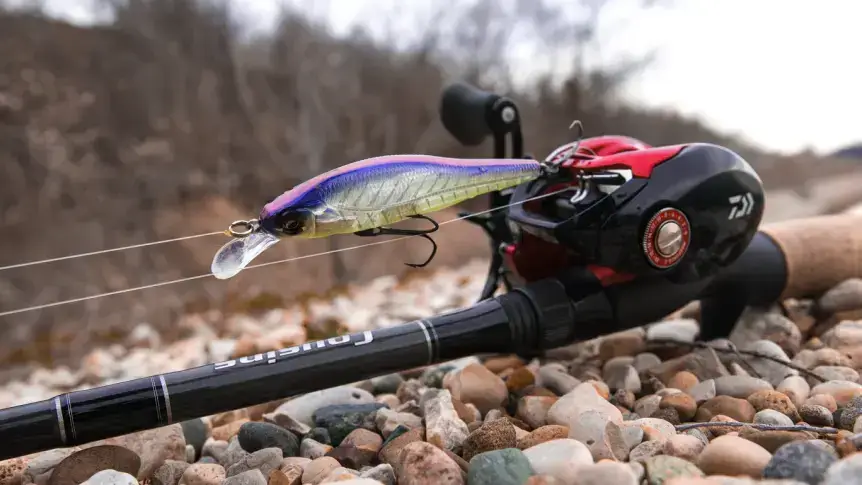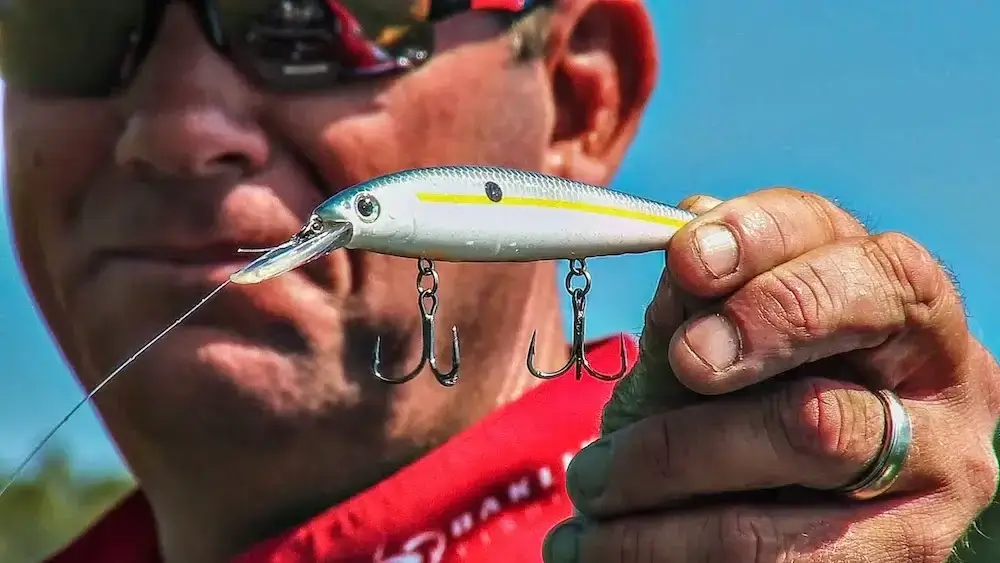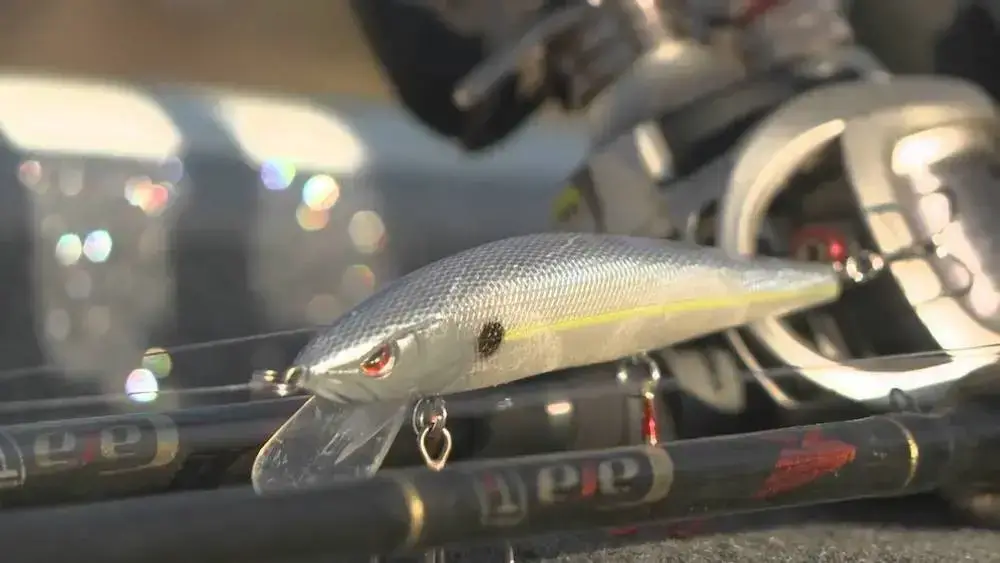When fishing for bass with jerkbaits, one of the most important decisions you will make is what line for Jerkbaits.
There are a lot of factors to consider when making this decision, including the weight and action of your chosen jerkbait, as well as the water conditions you will be fishing in.
In this blog post, we will discuss what line is best for jerkbaits, and how to choose the right one for your needs.
What Factors Need to Consider When Choosing a Line for Jerkbaits?

One of the most important factors in choosing the right line for jerkbaits is the diameter of the line. The larger the diameter, the more visible the line will be to fish.
If you’re fishing in clear water, you’ll want to use a thinner line so that the fish won’t see it as easily. However, in stained or muddy water, you can get away with using a thicker line because the fish won’t be able to see it as well.
Another factor to consider is the strength of the line. You’ll want to choose a strong line to handle your target fish.
If you’re fishing for smaller fish, you can get away with using a lighter line. But if you’re targeting larger fish, you’ll need to use a heavier line.
Finally, you’ll want to consider the price of the line. If you’re on a budget, you can find some good quality lines for less than $20. But if you’re willing to spend more, you can find lines that are even better quality.
What Is the Best Line for Jerkbaits in Different Fishing Conditions?
To fish with jerkbaits effectively, it is important to choose the right line. Your line can make a big difference in how well your jerkbaits perform. Here are some tips for choosing the best line for jerkbaits in different fishing conditions.
- If you are fishing in clear water, use a fluorocarbon line. Fluorocarbon is less visible in water than other types of lines, so it is less likely to spook fish.
- If fishing in muddy or stained water, use a monofilament line. Monofilament is more visible in water than fluorocarbon, making it less likely to get lost in murky water.
- If you are fishing in deep water, use a braided line. Braided lines are more durable than other lines, so they can handle the heavy weights needed to fish in deep water.
- If fishing in shallow water, use a monofilament or fluorocarbon line. These lines are less likely to get tangled in the shallows.
No matter what type of fishing you are doing, it is important to choose the right line for the conditions. Overall, Fluorocarbon is the best line for jerkbaits because it is less visible in water and more durable than other types of lines.
By following these tips, you will be able to choose the best line for your fishing conditions and catch more fish.
How Do You Tie on a Jerkbait Line Properly

There are a few ways to tie on a jerkbait line properly, and it depends on what type of fish you’re targeting. For example, if you’re fishing for bass, you’ll want to use a heavier line so that the bait sinks faster.
However, if you’re fishing for trout, you’ll want to use a lighter line so that the bait floats higher in the water.
Here are a few different ways that you can tie on a jerkbait line:
- First, using a Palomar knot: thread the line through the eye of the bait and double back around itself. Then, pull tight and trim the excess line.
- Using an Improved Clinch knot: thread the line through the eye of the bait and make five wraps around the standing line. Thread the end of the line through the loop and pull tight. Trim the excess line.
- Using a Uni Knot: thread the line through the eye of the bait and make six wraps around itself. Thread the end of the line through the loop and pull tight. Trim the excess line.
Which knot you use is really up to personal preference, but these are three of the most popular knots for tying on a jerkbait line.
Whichever knot you choose, make sure that it’s tied securely, so your bait doesn’t come loose while fishing.
Can You Use Monofilament Line to the Lure?
The answer is yes; you can use a monofilament line for jerkbaits. Many anglers do just that. However, there are a few things to consider before using the monofilament line to the lure.
First of all, the monofilament line has stretched. This stretch can be an advantage or a disadvantage depending on the situation.
The stretch can be advantageous because it allows the lure to have more action and makes it less likely for the fish to feel the line’s resistance. But, conversely, the stretch can be a disadvantage because it can make it harder to feel when a fish hits the lure.
Another thing to consider is the diameter of the monofilament line. The thicker the line, the more visible it will be to the fish. You may want to use a thinner line in clear water so that the fish will not see it as easily.
In stained or murky water, you may want to use a thicker line so that the fish will be able to see it.
There are a few other things to consider when using a monofilament line for jerkbaits, but these are the two most important factors.
If you keep these things in mind, you should be able to use the monofilament line successfully for your jerk baiting needs.
How Do You Handle Backlash When Using Jerkbaits?
Jerkbaits are a great way to catch fish, but they can be tricky to use. One of the biggest problems you can run into is backlash. When your line gets tangled, you can’t reel it in.
There are a few things you can do to avoid backlash. First, make sure you have the right line. You want a strong line to handle the fish you’re trying to catch but not so thick that it’s difficult to reel in.
Second, use a baitcaster instead of a spinning reel. This will help you avoid tangles. Finally, practice casting with your jerkbait before going out on the water. This will help you get a feel for using the bait without getting tangled up.
If you do end up with a tangle, don’t panic. Instead, take your time and carefully work the line out. With a little practice, you’ll be able to avoid backlash and catch some fish.
Tips on How to Set the Hook When Fishing with These Lures

The lure you use can make a big difference in how successful you are at setting the hook. Here are some tips to help you get started:
- Use a small, sharp hook. A larger, duller hook will only increase the chances of the fish getting away.
- Make sure the point of the hook is facing the right direction. If it’s not, the fish will be able to slip off more easily.
- Set the hook as soon as you feel a bite. The longer you wait, the more likely the fish will get away.
- Use a little bit of force. If you’re too gentle, the fish will be able to wiggle free. But if you use too much force, you risk tearing the fish’s mouth.
With these tips in mind, you should be able to set the hook more effectively and catch more fish.
Conclusion
In the end, it comes down to personal preference. Some anglers swear by fluorocarbon, while others prefer braided lines. Ultimately, the best line for jerkbaits is the one that you feel most comfortable using.
With so many different fishing lines on the market, it can be tough to decide which one is right for you. But if you keep these tips in mind, you should be able to find the perfect line for jerkbaits in no time.

